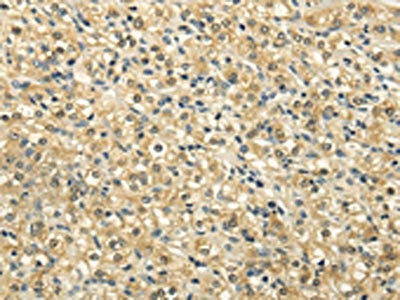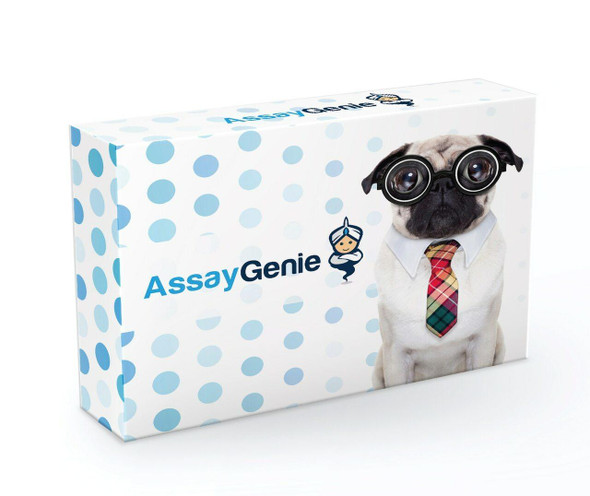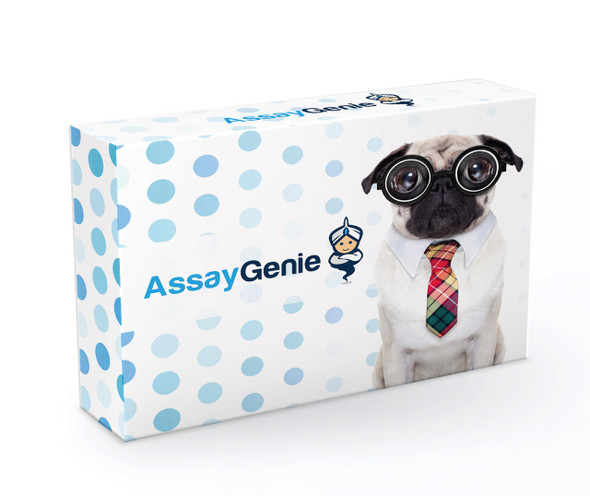Description
| Antibody Name: | NSD1 Antibody (PACO20829) |
| Antibody SKU: | PACO20829 |
| Size: | 50ul |
| Host Species: | Rabbit |
| Tested Applications: | ELISA, IHC |
| Recommended Dilutions: | ELISA:1:2000-1:5000, IHC:1:20-1:100 |
| Species Reactivity: | Human, Mouse |
| Immunogen: | Synthetic peptide of human NSD1 |
| Form: | Liquid |
| Storage Buffer: | -20°C, pH7.4 PBS, 0.05% NaN3, 40% Glycerol |
| Purification Method: | Antigen affinity purification |
| Clonality: | Polyclonal |
| Isotype: | IgG |
| Conjugate: | Non-conjugated |
 | The image on the left is immunohistochemistry of paraffin-embedded Human prostate cancer tissue using PACO20829(NSD1 Antibody) at dilution 1/25, on the right is treated with synthetic peptide. (Original magnification: x200)The image on the left is immunohistochemistry of paraffin-embedded Human lung cancer tissue using PACO20829(NSD1 Antibody) at dilution 1/25, on the right is treated with synthetic peptide. (Original magnification: x200). |
| Background: | This gene encodes a protein containing a SET domain, 2 LXXLL motifs, 3 nuclear translocation signals (NLSs), 4 plant homeodomain (PHD) finger regions, and a proline-rich region. The encoded protein enhances androgen receptor (AR) transactivation, and this enhancement can be increased further in the presence of other androgen receptor associated coregulators. This protein may act as a nucleus-localized, basic transcriptional factor and also as a bifunctional transcriptional regulator. Mutations of this gene have been associated with Sotos syndrome and Weaver syndrome. One version of childhood acute myeloid leukemia is the result of a cryptic translocation with the breakpoints occurring within nuclear receptor-binding Su-var, enhancer of zeste, and trithorax domain protein 1 on chromosome 5 and nucleoporin, 98-kd on chromosome 11. Two transcript variants encoding distinct isoforms have been identified for this gene. |
| Synonyms: | nuclear receptor binding SET domain protein 1 |
| UniProt Protein Function: | NSD1: Histone methyltransferase. Preferentially methylates 'Lys-36' of histone H3 and 'Lys-20' of histone H4 (in vitro). Transcriptional intermediary factor capable of both negatively or positively influencing transcription, depending on the cellular context. Defects in NSD1 are the cause of Sotos syndrome type 1 (SOTOS1); also known as cerebral gigantism. It is a disorder characterized by excessively rapid growth, acromegalic features, and a nonprogressive cerebral disorder with mental retardation. High-arched palate and prominent jaw are noted in several patients. Most cases of Sotos syndrome are sporadic and may represent new dominant mutation. Defects in NSD1 are the cause of Weaver syndrome type 1 (WVS1). A syndrome of accelerated growth and osseous maturation, unusual craniofacial appearance, hoarse and low- pitched cry, and hypertonia with camptodactyly. Distinguishing features of Weaver syndrome include broad forehead and face, ocular hypertelorism, prominent wide philtrum, micrognathia, deep horizontal chin groove, and deep-set nails. In addition, carpal bone development is advanced over the rest of the hand. Defects in NSD1 are a cause of Beckwith-Wiedemann syndrome (BWS). BWS is a genetically heterogeneous disorder characterized by anterior abdominal wall defects including exomphalos (omphalocele), pre- and postnatal overgrowth, and macroglossia. Additional less frequent complications include specific developmental defects and a predisposition to embryonal tumors. A chromosomal aberration involving NSD1 is found in childhood acute myeloid leukemia. Translocation t(5;11)(q35;p15.5) with NUP98. A chromosomal aberration involving NSD1 is found in an adult form of myelodysplastic syndrome (MDS). Insertion of NUP98 into NSD1 generates a NUP98-NSD1 fusion product. Belongs to the histone-lysine methyltransferase family. 3 isoforms of the human protein are produced by alternative splicing. |
| UniProt Protein Details: | Protein type:Methyltransferase; Methyltransferase, protein lysine; EC 2.1.1.43; Amino Acid Metabolism - lysine degradation; Nuclear receptor co-regulator; Oncoprotein; Transcription, coactivator/corepressor Chromosomal Location of Human Ortholog: 5q35 Cellular Component: nucleoplasm; nucleolus; chromosome; nucleus Molecular Function:retinoid X receptor binding; androgen receptor binding; zinc ion binding; retinoic acid receptor binding; histone lysine N-methyltransferase activity (H4-K20 specific); transcription cofactor activity; estrogen receptor binding; chromatin binding; thyroid hormone receptor binding; transcription corepressor activity; histone lysine N-methyltransferase activity (H3-K36 specific) Biological Process: histone methylation; establishment and/or maintenance of chromatin architecture; transcription, DNA-dependent; positive regulation of transcription, DNA-dependent; histone H3-K36 methylation; gastrulation with mouth forming second; negative regulation of transcription from RNA polymerase II promoter Disease: Sotos Syndrome 1; Beckwith-wiedemann Syndrome |
| NCBI Summary: | This gene encodes a protein containing a SET domain, 2 LXXLL motifs, 3 nuclear translocation signals (NLSs), 4 plant homeodomain (PHD) finger regions, and a proline-rich region. The encoded protein enhances androgen receptor (AR) transactivation, and this enhancement can be increased further in the presence of other androgen receptor associated coregulators. This protein may act as a nucleus-localized, basic transcriptional factor and also as a bifunctional transcriptional regulator. Mutations of this gene have been associated with Sotos syndrome and Weaver syndrome. One version of childhood acute myeloid leukemia is the result of a cryptic translocation with the breakpoints occurring within nuclear receptor-binding Su-var, enhancer of zeste, and trithorax domain protein 1 on chromosome 5 and nucleoporin, 98-kd on chromosome 11. Two transcript variants encoding distinct isoforms have been identified for this gene. [provided by RefSeq, Jul 2008] |
| UniProt Code: | Q96L73 |
| NCBI GenInfo Identifier: | 19923586 |
| NCBI Gene ID: | 64324 |
| NCBI Accession: | NP_071900.2 |
| UniProt Secondary Accession: | Q96L73,Q96PD8, Q96RN7, |
| UniProt Related Accession: | Q96L73 |
| Molecular Weight: | 296,652 Da |
| NCBI Full Name: | histone-lysine N-methyltransferase, H3 lysine-36 and H4 lysine-20 specific isoform b |
| NCBI Synonym Full Names: | nuclear receptor binding SET domain protein 1 |
| NCBI Official Symbol: | NSD1 |
| NCBI Official Synonym Symbols: | STO; KMT3B; SOTOS; ARA267; SOTOS1 |
| NCBI Protein Information: | histone-lysine N-methyltransferase, H3 lysine-36 and H4 lysine-20 specific; H3-K36-HMTase; H4-K20-HMTase; lysine N-methyltransferase 3B; NR-binding SET domain-containing protein; androgen receptor-associated coregulator 267; androgen receptor coactivator 267 kDa protein; androgen receptor-associated protein of 267 kDa; nuclear receptor-binding SET domain-containing protein 1 |
| UniProt Protein Name: | Histone-lysine N-methyltransferase, H3 lysine-36 and H4 lysine-20 specific |
| UniProt Synonym Protein Names: | Androgen receptor coactivator 267 kDa protein; Androgen receptor-associated protein of 267 kDa; H3-K36-HMTase; H4-K20-HMTase; Lysine N-methyltransferase 3B; Nuclear receptor-binding SET domain-containing protein 1; NR-binding SET domain-containing protein |
| Protein Family: | Histone-lysine N-methyltransferase |
| UniProt Gene Name: | NSD1 |
| UniProt Entry Name: | NSD1_HUMAN |






